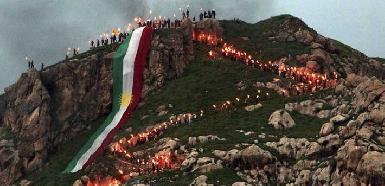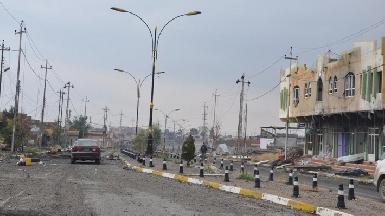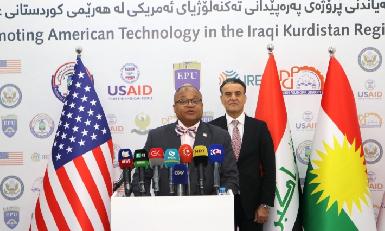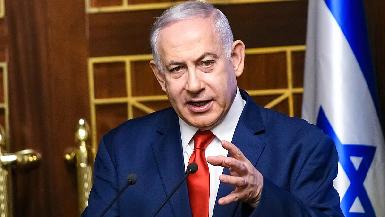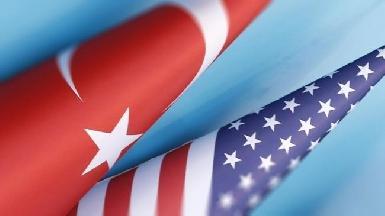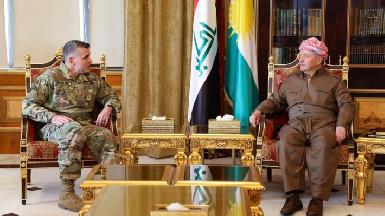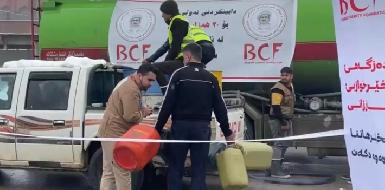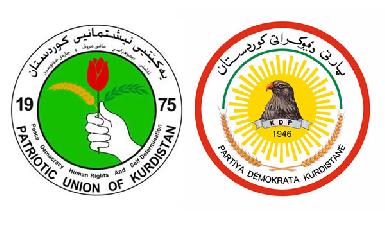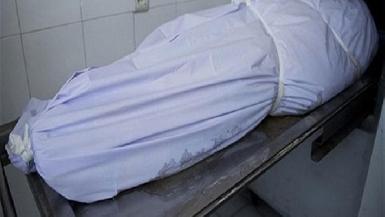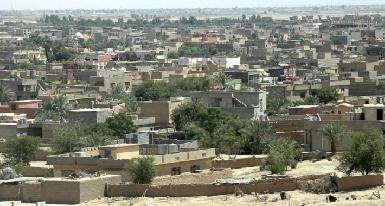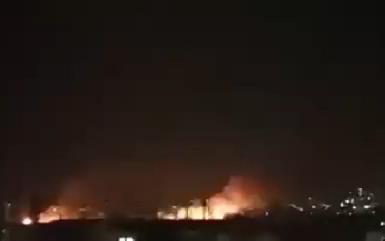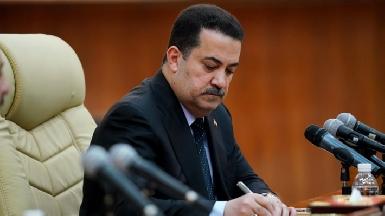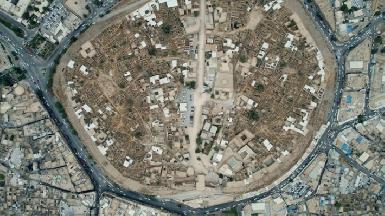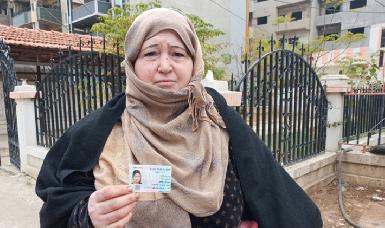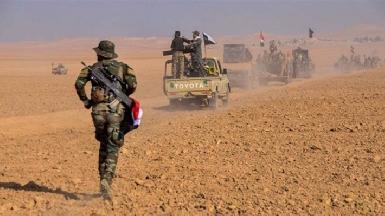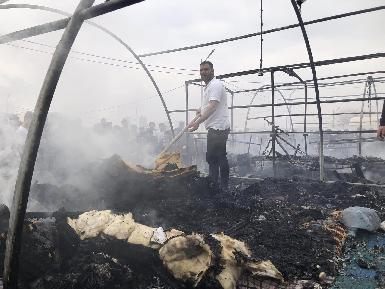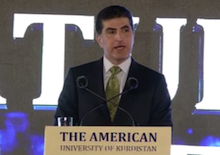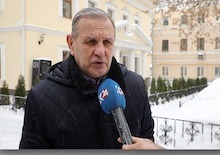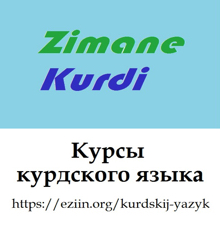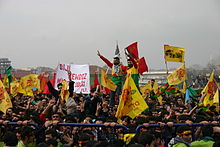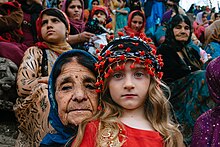В Курдистане объявлены дни празднования Науруза
| 1754 | 0 | |
|
2021-03-17
Региональное правительство Курдистана (КРГ) 16 марта объявило пять дней официальными праздниками по случаю курдского Нового года, также известного как Науруз.
Как сказано в заявлении пресс-секретаря КРГ Джотиара Адиля, праздники начнутся 21 марта и продлятся до 25 марта.
Представитель КРГ призвал граждан продолжать соблюдать официальные инструкции, чтобы помочь правительству сдержать распространение коронавируса.
Курдский Новый год приходится на 21 марта каждого года. Люди отмечают его в традиционных курдских нарядах, отправляясь на пикники и отмечая это событие праздничной едой, песнями и танцами.
Теги: Иракский Курдистан, Курдистан, КРГ, Науруз
еще нет ниодного комментария…
еще в рубрике
Синджар сформирует собственные силы для контроля над езидским районом
2023-01-31
Kurdistan.Ru
Администрация езидского города Синджар иракской провинции Ниневия начала регистрацию тех, кто желает присоединиться к местным силам, чтобы заменить пришлые вооруженные группы и восстановить безопасность в этом районе…
Контрабанда лекарств в Ираке представляет общественную опасность
2023-01-31
Kurdistan.Ru
Лекарства, ввозимые контрабандой в Ирак, продолжают представлять серьезную опасность для здоровья населения страны, что побуждает органы здравоохранения усилить меры противодействия…
США объявляют о финансировании создания ИТ-лабораторий в трех университетах Курдистана
2023-01-31
Kurdistan.Ru
Агентство США по международному развитию (USAID) объявило о проекте финансирования создания девяти лабораторий информационных технологий в трех университетах Иракского Курдистана…
Израиль и США намерены наращивать усилия по противодействию Ирану
2023-01-31
profile.ru
Соединённые Штаты и Израиль будут предпринимать все необходимые меры для того, чтобы Иран не получил ядерное оружие и средства его доставки. Две страны намерены наращивать усилия по противодействию Тегерану…
Оппозиция обещает вернуть демократическую систему в Турции, если победит на выборах в мае
2023-01-31
interfax.ru
Коалиция, состоящая из шести оппозиционных партий Турции, пообещала вернуть «либеральную и демократическую» систему, если ей удастся победить на запланированных на конец весны выборах, сообщает агентство Associated Press…
Посольство США в Турции предупредило об опасности терактов в Стамбуле
2023-01-30
eadaily.com
Посольство США в Турции предупредило находящихся в стране американцев о возможных нападениях на церкви, синагоги и дипмиссии в Стамбуле…
Масуд Барзани и делегация коалиции обсудили ход войны против ИГ
2023-01-30
Kurdistan.Ru
Курдский лидер Масуд Барзани, президент «Демократической партии Курдистана» (ДПК), 30 января принял делегацию возглавляемой США Международной коалиции по борьбе с «Исламским государством» (ИГ), чтобы обсудить террористичекую угрозу в регионе…
«Благотворительный фонд Барзани» привез печное топливо в Соран
2023-01-30
Kurdistan.Ru
«Благотворительный фонд Барзани» 30 января привез печное топливо для нуждающихся и уязвимых семей в городе Соран Иракского Курдистана, где выпал первый крупный снег…
Переговоры между ДПК и ПСК продвигаются вперед
2023-01-30
Kurdistan.Ru
Сообщается о достигнутом прогрессе в недавних переговорах между правящей «Демократической партией Курдистана» (ДПК) и конкурирующим «Патриотическим союзом Курдистана» (ПСК), которые встретились на прошлой неделе в Сулеймании…
В Ираке растет число самоубийств
2023-01-30
Kurdistan.Ru
В иракской провинции Ди-Кар наблюдается всплеск числа самоубийств, поскольку люди сталкиваются с растущими экономическими трудностями из-за разрушительной девальвации валюты…
США помогли 100 езидским семьям вернуться в Синджар
2023-01-30
Kurdistan.Ru
Правительство США недавно помогло почти 100 семьям, укрывавшимся в Иракском Курдистане после захвата их родных городов террористическим «Исламским государством» (ИГ, ИГИЛ), вернуться в их дома в районе Синджар иракской провинции Ниневия…
Авиаудар по автоколонне у границы с Ираком
2023-01-30
Kurdistan.Ru
29 января был нанесен авиаудар по автоколонне, предположительно принадлежащей проиранским военизированным группировкам, в районе, расположенном между Ираком и Сирией…
Премьер-министр Ирака готовит поправки в Конституцию
2023-01-30
Kurdistan.Ru
В качестве первого шага к внесению поправок в конституцию Ирака премьер-министр Мухаммед Шиа ас-Судани 29 января назначил Хасана Ниму аль-Ясири своим советником по конституционным вопросам…
В 2022 году власти Курдистана подписали 47 контрактов на реконструкцию исторических памятников
2023-01-30
Kurdistan.Ru
Региональное правительство Курдистана (КРГ) 29 января заявило о подписании в общей сложности 47 контрактов с университетами и иностранными организациями на разработку и реконструкцию археологических памятников…
«STJ»: в 2022 году РПК похитила в Сирии 49 детей
2023-01-30
Kurdistan.Ru
В 2022 году в Сирийском Курдистане вооруженная группа, связанная с турецкой «Рабочей партией Курдистана» (РПК), похитила в общей сложности 49 детей. Об этом сказано в отчете организации «Сирийцы за правду и справедливость» (STJ)…
Иракские силы захватили «лучшего убийцу» ИГ в Багдаде
2023-01-29
Kurdistan.Ru
Проиранские ополченцы «Хашд аш-Шааби» 28 января объявили о захвате боевика «Исламского государства» (ИГ), который раньше являлся «главным убийцей» террористической группировки в Багдаде…
Дохук: пожар в лагере для перемещенных езидов
2023-01-29
Kurdistan.Ru
В воскресенье в лагере в провинции Дохук, где проживают перемещенные семьи езидов, вспыхнул пожар. О пострадавших не сообщается…
другие возможности
Прямая трансляция KurdistanTV
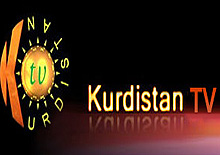
| Февраль | ||||||
| Пн | Вт | Ср | Чт | Пт | Сб | Вс |
| 30 | 31 | 1 | 2 | 3 | 4 | 5 |
| 6 | 7 | 8 | 9 | 10 | 11 | 12 |
| 13 | 14 | 15 | 16 | 17 | 18 | 19 |
| 20 | 21 | 22 | 23 | 24 | 25 | 26 |
| 27 | 28 |
Смотрите канал KurdistanRuVideoNews
Смотрите канал KurdistanRuCollect
Kurdistan Democratic Party
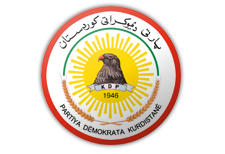
Считаете ли вы, что езидский Синджар в ближайшем времени станет безопасным районом?
Kurdistan.Ru в социальных сетях
0. ЖИГАЛИНА, д.и.н
Неотъемлемой частью национальной культуры курдов являются праздники и обряды. Они связаны в основном с хозяйственной деятельностью курдов, которые по традиции были умелыми скотоводами и усердными земледельцами.
Праздник Beran berdan
Как у многих народов Востока, большие праздники у курдов приурочивают к новым периодам года, который начинается 21 марта. Именно таким праздником является Навруз (Новый год). Ему предшествовали менее значительные, но являвшиеся традиционно народными праздники, которые рассматривались курдами как предтеча предстоящих новогодних торжеств. Такими предшественниками Навруза являются праздник Хыдыр-Наби и отмечаемый только курдами-езидами праздник обновления «Эйде серсале» (Навруз).
Праздник Хыдыр-Наби — покровителя скота и растительности, олицетворяющего вечную жизнь и весну, устраивается между рождественским и великим постами, соблюдаемыми христианами. Курды постятся три дня, после чего разговляются. Вечером третьего дня и наутро следующего из каждого дома разносят соседям еду в память умерших. Курдянки жидким тестом рисуют на притолоке и потолочных балках магические знаки-обереги: курды-езиды изображают диски солнца, луны, а также фигурки человечков, скота, круги и точки. Все эти знаки призывали милость Хыдыр-Наби и обеспечивали благополучие дома и богатый приплод. У курдов-езидов совершали в это время обряд колядования. Дети и молодежь, взяв мешочек (или новый шерстяной носок) на длинной нитке (называемый «Доли-данг»), ходят по домам с песнями. Детям непременно дают фрукты и сладости.
Песни — излюбленный вид народного творчества у курдов. Они передаются из поколения в поколение, приобретая новое содержание. Наиболее распространены массовые песни, но исполняются и сольные. Музыкой и песнями сопровождаются и народные курдские пляски, преимущественно групповые, типа хороводных танцев.
В ночь на праздник Хыдыр-Наби кладут муку в деревянное корыто и ставят на середину комнаты. Считают, что конь Хыдыр-Наби оставляет на муке свои следы; хозяин дома радуется и говорит: «Благословение и милость пророка Хыдыра нынче снизошла ко мне в дом».
По традиции, 21 марта курды отмечали самый большой праздник Навруз, к которому приурочивали весенние посевы и первый выгон скота. Он был связан с отелом скота и отмечался обычно в период весеннего полнолуния или новолуния.
Для курдов Навруз — не только праздник весны и обновления, но и национальный праздник, так как они связывают, его с освобождением своей земли от тирании царя-дракона Захока-Беварасла, воспетого в легендах.
Новый год не обходился без обильного застолья. Курды любят жарить шашлык. Его приготовлением занимаются по обыкновению мужчины, обычно хозяин дома или его старшие сыновья. Распространены сладкие пловы. Варят пшеницу, называемую савар, сдабривая ее медом. Много готовят мучных изделий и пьют чай. Чаепитие является ритуалом, во время которого обмениваются не только новостями, но и сплетнями.
У курдов-земледельцев бытовали обряды, связанные с водой. Их выполняли женщины. Для того, чтобы умилостивить небо во время засухи, они запрягали волов в соху и пахали не землю, а воду. С этой же целью в засушливые дни женщины обливали друг друга водой.
Первая избранница…
Новый, летний сельскохозяйственный цикл начинался у курдов-скотоводов
с перекочевки на летовки. К этому времени приурочивали праздник, когда ягнят смешивали с матерями. До прибытия на летовку ягнята свободно кормились у матерей, а телят не подпускали к сосанию молока и им надевали намордники. Подобные обычаи, связанные с переходом на летовку, встречаются также и в быту других народов, занимающихся скотоводством.
Осенью курды (сельское население) проводят Праздник Беран-Бердан (буквально «запуск баранов»), означающий обычай запуска баранов в стадо. Когда наступает середина осени (сентябрь-октябрь), курды пекут хлеба, гату (сладкое печенье с прослойкой масла и сахара) и несут их к отарам. Там они раздают всем присутствующим гату, едят сами и веселятся. Потом пускают баранов в стада. Случка всегда сопровождалась обрядовыми действиями и происходила на 40-й день, то есть первой декады октября с тем, чтобы скот произошел в ранневесенний пастбищный период. Но обеспечение воспроизводства стада на следующий год начиналось уже зимой, в самый сложный период для скотоводов.
Через 100 дней после запуска баранов в стадо курды-скотоводы, когда удостоверяются, что овцы дадут приплод, отмечают праздник Сада-пез.
В домах снова готовят гату и различные кушанья. Люди веселятся, радуясь, что скоро стадо увеличится. У курдов-езидов во время этого праздника ходят ряженые: обычно это двое мужчин. Один из них, одетый в смешной и нелепый наряд, изображает комический персонаж Косгельды. Второй, одетый в женское платье, изображает его жену. Они ходят по деревне, заходят в дома, шутят, балагурят, собирая в мешок щедро раздаваемые угощения и деньги.
Последнюю среду месяца шубат курды называют праздником Ахыр-чаршам-бе (черная Среда). В этот день веселятся и стараются ни с кем не ссориться. Каждый у себя готовит много еды: считается, что весь год каждый будет заниматься тем же самым, что он делал в этот день. В праздничные
дни все непременно готовят халису (кушанье, приготовляемое из цельных зерен пшеницы, куриного мяса и топленого масла). В эти дни, если двое были в ссоре или враждовали, обязательно должны помириться и начать разговаривать друг с другом. В течение трех дней ходят друг к другу в гости, делают подарки.
Зимой, самой «сказочной» порой, сельское население собиралось по вечерам в чьем-либо доме, в большой комнате — гостиной (ода). Здесь состязались дангбежи — певцы; приглашались и музыканты. На вечеринку собиралась вся холостая молодежь селения — девушки и юноши, молодые женщины. Играли на сазе, пели, плясали в хороводе до самого утра. Рассказывали волшебные сказки. Курды по обыкновению рассказывали их вечерами. Ни один из сказочников не соглашался рассказывать днем волшебную сказку. В прошлом в каждой деревне существовали свои профессиональные сказочники и дангбежи.
Зимой курды-езиды проводят свой праздник Айда-Езди. Ежегодно в декабре (по григорианскому календарю) езиды соблюдали трехдневный пост (рожи езди). Днем они ничего не ели. В полночь накануне поста готовили обед, наедались и ложились спать. На следующий день не ели, не пили, не курили до захода солнца. После захода солнца ели, ложились спать и снова вставали в полночь. Так продолжалось три дня. На четвертый день устраивали праздник — Аида-Езди. В этот день на улицах селения собирались старики группами по несколько человек, ходили по домам односельчан, посещая в первую очередь тех, у кого недавно кто-нибудь умер. Там им устраивали угощение.
Курды-мусульмане отмечали праздники, связанные с исламом, в том числе Рамазан — праздник разговения. Эйда курбане — праздник жертвоприношения, мевлуд — День рождения пророка Мухаммеда, Ашуру и некоторые другие. Особенности политической истории и социально-экономического развития курдского народа наложили глубокий отпечаток на специфику этого этнокультурного бытия. Неоднократный раздел Курдистана — ареала исконного обитания курдов в Западной Азии — между различными государствами, привел к чересполосному их расселению с другими народами региона. Это обстоятельство способствовало сложению хозяйственно-культурных контактов между различными общественными группами, что отразилось на синкретично-сти календарных обычаев и обрядов курдов как по происхождению, так и по форме бытования. При этом возникает возможность выявить отдельные напластования различных эпох, религий, а также ареальную специфику проведения тех или иных праздников.
Журнал «Дружба». 1998 г. №4. СС. 38-40. Г. Москва.
From Wikipedia, the free encyclopedia
| Newroz نەورۆز |
|
|---|---|
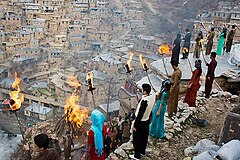
Kurds celebrating Newroz in the village of Pallingan. |
|
| Type | National, ethnic, international |
| Significance | New Year holiday |
| Date | Usually on March 21; but also 19 and 20. |
| 2023 date | Monday 20 March 2023 at 21:24 UTC * |
| 2024 date | Wednesday 20 March 2024 at 03:06 UTC * |
| Frequency | annual |
Newroz or Nawroz[1] (Kurdish: نەورۆز, Newroz)[2] is the Kurdish celebration of Nowruz; the arrival of spring and new year in Kurdish culture. The lighting of the fires at the beginning of the evening of March 21 is the main symbol of Newroz among the Kurds.
In Zoroastrianism, fire is a symbol of light, goodness and purification. Angra Mainyu, the demonic anti-thesis of Ahura Mazda, was defied by Zoroastrians with a big fire every year, which symbolized their defiance of and hatred for evil and the arch-demon. In Kurdish legend, the holiday celebrates the deliverance of the Kurds from a tyrant, and it is seen as another way of demonstrating support for the Kurdish cause.[3][4][5][6][7] The celebration coincides with the March equinox which usually falls on 21 March[8] and is usually held between 18 and 24 March. The festival has an important place in terms of Kurdish identity for the majority of Kurds.[3][4][6] Though celebrations vary, people generally gather together to welcome the coming of spring; they wear traditional coloured Kurdish clothes, dance together, light fires to dance around and jump over the bonfire, play Kurdish games.[9][10]
Mythology[edit]
The arrival of spring has been celebrated in Asia Minor since neolithic times. The root of this story goes back to ancient Iranian legends, retold in General History by scientist Dinawari,[11] The Meadows of Gold by Muslim historian Masudi,[12] the Shahnameh, a poetic opus written by the Persian poet Ferdowsi around 1000 AD, and the Sharafnameh by the medieval Kurdish historian Sherefxan Bidlisi.
Zahak, who is named Zuhak by the Kurds,[3][13] was an evil Assyrian king who conquered Iran and had serpents growing from his shoulders.[14] Zahak’s rule lasted for one thousand years; his evil reign caused spring to no longer come to Kurdistan.[3] During this time, two young men were sacrificed daily and their brains were offered to Zahak’s serpents in order to alleviate his pain.[14] However, the man who was in charge of sacrificing the two young men every day would instead kill only one man a day and mix his brains with those of a sheep in order to save the other man. As discontent grew against Zahak’s rule, the nobleman Fereydun planned a revolt.[15] The revolt was led by Kaveh (also known as Kawa) (in the Ossetian language, Kurdalægon), a blacksmith who had lost six sons to Zahak.[14] The young men who had been saved from the fate of being sacrificed (who according to the legend were ancestors of the Kurds[11][12][16]) were trained by Kaveh into an army that marched to Zahak’s castle where Kaveh killed the king with a hammer. Kaveh is said to have then set fire to the hillsides to celebrate the victory and summon his supporters; spring returned to Kurdistan the next day.[3]
March 20 is traditionally marked as the day that Kaveh defeated Zahak. This legend is now used by the Kurds to remind themselves that they are a different, strong people, and the lighting of the fires has since become a symbol of freedom.[3] It is a tradition to jump across a fire at Newroz.
According to Evliya Çelebi, the district (sancak) of Merkawe in Shahrazur in the southeastern part of Iraqi Kurdistan is named after Kaveh.[17] The 12th century geographer Yaqoot Hamawi mentions Zor (Zur[17]), son of Zahhak (Aji Dahak), as founder of the famous city of Sharazor.[18]
It is a tradition to jump across a fire at Newroz.
In the 1930s, the Kurdish poet Taufik Abdullah, wanting to instill a new Kurdish cultural revival, used a previously known, modified version of the story of Kawa.[3] He connected the myths where people felt oppressed with Newroz, thus reviving a dying holiday and making it a symbol of the Kurdish national struggle.[3][19]
Newroz customs and celebration[edit]
Newroz is considered the most important festival in Kurdish culture, and is a time for entertainment such as games, dancing, family gathering, preparation of special foods and the reading of poetry.[20] The celebration of Newroz has its local peculiarities in different regions of Kurdistan.[20] On the eve of Newroz, in southern and eastern Kurdistan, bonfires are lit. These fires symbolize the passing of the dark season, winter, and the arrival of spring, the season of light.[20] The 17th century Kurdish poet Ahmad Khani mentions in one of his poems how the people, youth and elderly, leave their houses and gather in countryside to celebrate Newroz.[citation needed]
Armenian scholar Mardiros Ananikian [21] emphasizes the identical nature of Newroz and the Armenian traditional New Year, Navasard, noting that it was only in the 11th century that Navasard came to be celebrated in late summer rather than in early spring. He states that the Newroz – Navasard “was an agricultural celebration connected with commemoration of the dead […] and aiming at the increase of the rain and the harvests.”1 The great center of Armenian Navasard, Ananikian points out, was Bagavan, the center of fire worship.
Political overtones[edit]
The Kurdish association with Newroz has become increasingly pronounced since the 1950s when the Kurds in the Middle East and those in the diaspora in Europe started adopting it as a tradition.[22] Following the persecution of any Kurdish expression in Turkey, the revival of the Newroz celebration has become more intense and politicized and has also become a symbol of the Kurdish resurrection.[4] By the end of the 1980s, Newroz was mainly associated «with the attempts to express and resurrect» the Kurdish identity.[22]
In 1991, the Turkish minister of Culture Namık Kemal Zeybek gave out the directive to hold the Nevruz holiday.[23] During the leadership of Prime Minister Suleyman Demirel Turkey legalized the celebration of Nevruz, spelling it «Nevruz» and claiming its origins were to be found in Central Asia.[24] The Government was attempting to counter the rising Kurdish nationalism.[24] Using the Kurdish spelling «Newroz» has been officially forbidden,[25] though it is still widely used by Kurds. Several Turkish newspapers were prosecuted for the spelling of Newroz.[26][27] In the Kurdish regions of Turkey, specifically in Eastern Anatolia but also in Istanbul and Ankara where there are large Kurdish populations, people gather and jump over bonfires.[4] Previous to it being legalized, the PKK, the Kurdistan Workers’ Party, had chosen the date of the Newroz festival to stage attacks to obtain publicity for their cause;[4][28] this led to Turkish forces detaining thousands of people who were seen as supporters of the Kurdish rebel movements.[29] During the Newroz celebrations of 1992, more than 90 Kurdish participants were killed by the Turkish government.[30] In 2008, two participants were killed.[31]
In Syria, the Kurds dress up in their national dress and celebrate the new year.[32] According to Human Rights Watch, Syrian Kurds have had to struggle to celebrate Newroz, and in the past the celebration has led to violent oppression, leading to several deaths and mass arrests.[6][33] The government has stated that the Newroz celebrations will be tolerated as long as they do not become political demonstrations of the treatment of the Kurds.[6] During the Newroz celebrations in 2008, three Kurds were shot dead by Syrian security forces.[34][35]
Kurds in the diaspora also celebrate the new year: Kurds in Australia celebrate Newroz not only as the beginning of the new year but also as Kurdish National Day;[5] the Kurds in Finland celebrate the new year as a way of demonstrating their support for the Kurdish cause.[36] In London, organizers estimated that 25,000 people celebrated Newroz in March 2006.[37]
Newroz in Kurdish literature[edit]
Newroz has been mentioned in works of many Kurdish poets and writers as well as musicians.[38] One of the earliest records of Newroz in Kurdish literature is from Melayê Cizîrî (1570–1640):[39]
Without the light and the fire of Love,
Without the Designer and the power of Creator,
We are not able to reach Union.
(Light is for us and dark is the night)This fire massing and washing the Heart,
My heart claim after it.
And here come Newroz and the New Year,
When a such light is rising.
The famous Kurdish writer and poet Piramerd (1867–1950) writes in his 1948 poem Newroz:[40]
The New Year’s day is today. Newroz is back.
An ancient Kurdish festival, with joy and verdure.
For many years, the flower of our hopes was downtrodden
The poppy of spring was the blood of the youth
It was that red colour on the high horizon of Kurd
Which was carrying the happy tidings of dawn to remote and near nations
It was Newroz which imbued the hearts with such a fire
That made the youth receive death with devoted love
Hooray! The sun is shining from the high mountains of homeland
It is the blood of our martyrs which the horizon reflects
It has never happened in the history of any nation
To have the breasts of girls as shields against bullets
Nay. It is not worth crying and mourning for the martyrs of homeland
They die not. They live on in the heart of the nation.
Gallery[edit]
-
Kurdish students performing Kurdish dances to celebrate Newroz at Dicle University
-
Kurdish people celebrating Newroz 2018, Tangi Sar
-
Newroz celebration by the Kurds in Istanbul, 2006
-
Newroz in Iranian Kurdistan, 2017
-
Village girl in Palangan prepares to kindle fire for Newroz, 2019
See also[edit]
- Yazidi New Year
- Yaldā Night
References[edit]
- ^ Thomas Bois, Connaissance des Students, 164 pp., 1965. (see p. 69)
- ^ Abdurrahman Sharafkandi (Hejar), Henbane Borîne (Kurdish-Kurdish-Persian Dictionary), Soroush Press, 1991, Tehran, p. 715
- ^ a b c d e f g h Murphy, Dan (2004-03-24). «For Kurds, a day of bonfires, legends, and independence». The Christian Science Monitor. Retrieved 2007-03-08.
- ^ a b c d e Yanik, Lerna K. (March 2006). «‘Nevruz’ or ‘Newroz’? Deconstructing the ‘Invention’ of a Contested Tradition in Contemporary Turkey». Middle Eastern Studies. 42 (2): 287. doi:10.1080/00263200500417710. hdl:11693/49511. S2CID 143682680.
- ^ a b Jupp, James (2001). The Australian People: An Encyclopedia of the Nation, its People and their Origins. Cambridge: Cambridge University Press. ISBN 0-521-80789-1.
- ^ a b c d Yildiz, Kerim; Fryer, Georgina (2004). The Kurds: Culture and Language Rights. Kurdish Human Rights Project. ISBN 1-900175-74-6.
- ^ Wahlbeck, Osten (1999). Kurdish Diasporas: A Comparative Study of Kurdish Refugee Communities (Migration, Minorities and Citizenship). Basingstoke: Macmillan. ISBN 0-312-22067-7.
- ^ «Newroz – Kurdish New Year». BBC.
- ^ Frantz, Douglas (2001-03-23). «Diyarbakir Journal: Where Misery Abounds, the Kurds Make Merry». The New York Times. Archived from the original on 2007-02-16. Retrieved 2007-03-08.
- ^ Macris, Gina (2002-03-25). «Kurds Ring in New Year». Providence Journal. Archived from the original on 2006-12-17. Retrieved 2007-03-08.
- ^ a b al-Dinawari, Ahmad b. Dawud. Kitab al-akhbar al-tiwal. Edited by V.Guirgass. Leiden. 1888, see p. 7
- ^ a b Hakan Ozoglu, Kurdish notables and the Ottoman State, 2004, SUNY Press, page: 30. ISBN 0-7914-5993-4
- ^ Kurdish Institute of Paris (March 2001). «Newroz 2001: In Diyarbekir the celebrations brought together 500,000 people in a calm atmosphere, but there were many incidents in Istanbul». Retrieved 2007-03-13.
- ^ a b c Warner, Marina; Fernández-Armesto, Felipe (2004). World of Myths: Roman Myths. University of Texas Press. ISBN 0-292-70607-3.
- ^ In some of the present Kurdish versions of the story of Zahak and Kawa, there is no mention of Fereydun. van Bruinessen, Vol. 3, pp. 1–11, 2000. In the Ahl-e Haqq (Yarsan) Kurdish tradition, Kawa rebelled against Zahak and helped Fereydun imprison Zahak inside Mount Damavand. Hajj Nematollah, Shah-Nama-Ye Haqiqat, Intishaaraat Jeyhun (1982).
- ^ 05001 Zahak Archived 2007-03-06 at the Wayback Machine
- ^ a b Martin van Bruinessen, «Kurdistan in the 16th and 17th centuries, as reflected in Elviya Çelebi’s Seyahatname», The Journal of Kurdish Studies, Vol. 3, pp. 1–11, 2000.
- ^ Kitab Mu’jam Al Buldan by Yaqoot Hamawi, Book 3, p: 425-427
- ^ Connecting celebration of the new year with injustice and oppression is also reflected in the Coptic celebration of Nayrouz, whose chronology begins when Diocletian became Roman emperor.
- ^ a b c H. Betteridge, G. Kreyenbroek, Hitchins, Anne, EIr, Philip, Keith. «FESTIVALS, KURDISH (SUNNI)». Encyclopædia Iranica. Retrieved 2015-01-27.
{{cite encyclopedia}}: CS1 maint: multiple names: authors list (link) - ^ Ananikean, M. H. (2010). Armenian mythology : stories of Armenian gods and goddesses, heroes and heroines, hells & heavens, folklore & fairy tales. Los Angeles: IndoEuropean Publishing.com. ISBN 9781604441727.
- ^ a b Yanik, Lerna K. (2006). «‘Nevruz’ or ‘Newroz’? Deconstructing the ‘Invention’ of a Contested Tradition in Contemporary Turkey». Middle Eastern Studies. 42 (2): 287. doi:10.1080/00263200500417710. hdl:11693/49511. ISSN 0026-3206. JSTOR 4284447. S2CID 143682680.
- ^ Yanik, Lerna K. (2006). pp.287–288
- ^ a b Yanik, Lerna K. (2006). p.288
- ^ Bianet :: Let Newroz and Nevruz bring Peace and Spring! Archived 2008-03-22 at the Wayback Machine
- ^ Meho, Lokman I. (2004). The Kurdish Question in U.S. Foreign Policy: A Documentary Sourcebook. Greenwood Publishing Group. p. 400. ISBN 978-0-313-31435-3.
- ^ Korkut, Tolga. ««Newroz» and «Kawa» Reason for Imprisonment?». Bianet.
- ^ Aykan, Bahar (2014-12-17). «Whose Tradition, Whose Identity? The politics of constructing «Nevruz» as intangible heritage in Turkey». European Journal of Turkish Studies. Social Sciences on Contemporary Turkey (19). doi:10.4000/ejts.5000. ISSN 1773-0546.
- ^ «Turkish police arrest thousands». BBC. 1999-03-22. Retrieved 2007-03-10.
- ^ «The Kurds of Turkey: Killings, Disappearance and Torture» (PDF). HRW. 1993-03-21. Retrieved 2016-02-21.
- ^ «Two demonstrators die in Turkey clashes». RTÉ News. 2008-03-23.
- ^ Kreyenbroek, Philip G.; Sperl, Stefan Sperl (1991). The Kurds. Routledge. ISBN 0-415-07265-4.
- ^ Amnesty International (2004-03-16). «Syria: Mass arrests of Syrian Kurds and fear of torture and other ill-treatment». Amnesty International. Archived from the original on 2006-11-19. Retrieved 2007-03-10.
- ^ Three Kurds killed in Syria shooting, human rights group says – Middle East Archived 2012-03-21 at the Wayback Machine
- ^ «Police kill three Kurds in northeast Syria – group». Reuters. 2008-03-21.
- ^ Wahlbeck, Osten (1999). Kurdish Diasporas: A Comparative Study of Kurdish Refugee Communities. Palgrave Macmillan. ISBN 0-312-22067-7.
- ^ «London celebrates Newroz: The Kurdish New Year». The Londoner. March 2006. Archived from the original on May 23, 2006. Retrieved 2007-03-10.
- ^ van Bruinessen, Martin (2000). «Transnational aspects of the Kurdish question». Florence: Robert Schuman Centre for Advanced Studies, European University Institute.
- ^ Alexie, Sandrine (2007-03-21). «Newroz û Sersal (Newroz and New Year)». Roj Bash. Archived from the original on September 30, 2007. Retrieved 2007-03-22.
- ^ Mirawdeli, Kamal (2005-03-21). «The old man and the fire». Kurdistan Referendum Movement. Archived from the original on 2007-10-11. Retrieved 2007-03-08.
From Wikipedia, the free encyclopedia
| Newroz نەورۆز |
|
|---|---|

Kurds celebrating Newroz in the village of Pallingan. |
|
| Type | National, ethnic, international |
| Significance | New Year holiday |
| Date | Usually on March 21; but also 19 and 20. |
| 2023 date | Monday 20 March 2023 at 21:24 UTC * |
| 2024 date | Wednesday 20 March 2024 at 03:06 UTC * |
| Frequency | annual |
Newroz or Nawroz[1] (Kurdish: نەورۆز, Newroz)[2] is the Kurdish celebration of Nowruz; the arrival of spring and new year in Kurdish culture. The lighting of the fires at the beginning of the evening of March 21 is the main symbol of Newroz among the Kurds.
In Zoroastrianism, fire is a symbol of light, goodness and purification. Angra Mainyu, the demonic anti-thesis of Ahura Mazda, was defied by Zoroastrians with a big fire every year, which symbolized their defiance of and hatred for evil and the arch-demon. In Kurdish legend, the holiday celebrates the deliverance of the Kurds from a tyrant, and it is seen as another way of demonstrating support for the Kurdish cause.[3][4][5][6][7] The celebration coincides with the March equinox which usually falls on 21 March[8] and is usually held between 18 and 24 March. The festival has an important place in terms of Kurdish identity for the majority of Kurds.[3][4][6] Though celebrations vary, people generally gather together to welcome the coming of spring; they wear traditional coloured Kurdish clothes, dance together, light fires to dance around and jump over the bonfire, play Kurdish games.[9][10]
Mythology[edit]
The arrival of spring has been celebrated in Asia Minor since neolithic times. The root of this story goes back to ancient Iranian legends, retold in General History by scientist Dinawari,[11] The Meadows of Gold by Muslim historian Masudi,[12] the Shahnameh, a poetic opus written by the Persian poet Ferdowsi around 1000 AD, and the Sharafnameh by the medieval Kurdish historian Sherefxan Bidlisi.
Zahak, who is named Zuhak by the Kurds,[3][13] was an evil Assyrian king who conquered Iran and had serpents growing from his shoulders.[14] Zahak’s rule lasted for one thousand years; his evil reign caused spring to no longer come to Kurdistan.[3] During this time, two young men were sacrificed daily and their brains were offered to Zahak’s serpents in order to alleviate his pain.[14] However, the man who was in charge of sacrificing the two young men every day would instead kill only one man a day and mix his brains with those of a sheep in order to save the other man. As discontent grew against Zahak’s rule, the nobleman Fereydun planned a revolt.[15] The revolt was led by Kaveh (also known as Kawa) (in the Ossetian language, Kurdalægon), a blacksmith who had lost six sons to Zahak.[14] The young men who had been saved from the fate of being sacrificed (who according to the legend were ancestors of the Kurds[11][12][16]) were trained by Kaveh into an army that marched to Zahak’s castle where Kaveh killed the king with a hammer. Kaveh is said to have then set fire to the hillsides to celebrate the victory and summon his supporters; spring returned to Kurdistan the next day.[3]
March 20 is traditionally marked as the day that Kaveh defeated Zahak. This legend is now used by the Kurds to remind themselves that they are a different, strong people, and the lighting of the fires has since become a symbol of freedom.[3] It is a tradition to jump across a fire at Newroz.
According to Evliya Çelebi, the district (sancak) of Merkawe in Shahrazur in the southeastern part of Iraqi Kurdistan is named after Kaveh.[17] The 12th century geographer Yaqoot Hamawi mentions Zor (Zur[17]), son of Zahhak (Aji Dahak), as founder of the famous city of Sharazor.[18]
It is a tradition to jump across a fire at Newroz.
In the 1930s, the Kurdish poet Taufik Abdullah, wanting to instill a new Kurdish cultural revival, used a previously known, modified version of the story of Kawa.[3] He connected the myths where people felt oppressed with Newroz, thus reviving a dying holiday and making it a symbol of the Kurdish national struggle.[3][19]
Newroz customs and celebration[edit]
Newroz is considered the most important festival in Kurdish culture, and is a time for entertainment such as games, dancing, family gathering, preparation of special foods and the reading of poetry.[20] The celebration of Newroz has its local peculiarities in different regions of Kurdistan.[20] On the eve of Newroz, in southern and eastern Kurdistan, bonfires are lit. These fires symbolize the passing of the dark season, winter, and the arrival of spring, the season of light.[20] The 17th century Kurdish poet Ahmad Khani mentions in one of his poems how the people, youth and elderly, leave their houses and gather in countryside to celebrate Newroz.[citation needed]
Armenian scholar Mardiros Ananikian [21] emphasizes the identical nature of Newroz and the Armenian traditional New Year, Navasard, noting that it was only in the 11th century that Navasard came to be celebrated in late summer rather than in early spring. He states that the Newroz – Navasard “was an agricultural celebration connected with commemoration of the dead […] and aiming at the increase of the rain and the harvests.”1 The great center of Armenian Navasard, Ananikian points out, was Bagavan, the center of fire worship.
Political overtones[edit]
The Kurdish association with Newroz has become increasingly pronounced since the 1950s when the Kurds in the Middle East and those in the diaspora in Europe started adopting it as a tradition.[22] Following the persecution of any Kurdish expression in Turkey, the revival of the Newroz celebration has become more intense and politicized and has also become a symbol of the Kurdish resurrection.[4] By the end of the 1980s, Newroz was mainly associated «with the attempts to express and resurrect» the Kurdish identity.[22]
In 1991, the Turkish minister of Culture Namık Kemal Zeybek gave out the directive to hold the Nevruz holiday.[23] During the leadership of Prime Minister Suleyman Demirel Turkey legalized the celebration of Nevruz, spelling it «Nevruz» and claiming its origins were to be found in Central Asia.[24] The Government was attempting to counter the rising Kurdish nationalism.[24] Using the Kurdish spelling «Newroz» has been officially forbidden,[25] though it is still widely used by Kurds. Several Turkish newspapers were prosecuted for the spelling of Newroz.[26][27] In the Kurdish regions of Turkey, specifically in Eastern Anatolia but also in Istanbul and Ankara where there are large Kurdish populations, people gather and jump over bonfires.[4] Previous to it being legalized, the PKK, the Kurdistan Workers’ Party, had chosen the date of the Newroz festival to stage attacks to obtain publicity for their cause;[4][28] this led to Turkish forces detaining thousands of people who were seen as supporters of the Kurdish rebel movements.[29] During the Newroz celebrations of 1992, more than 90 Kurdish participants were killed by the Turkish government.[30] In 2008, two participants were killed.[31]
In Syria, the Kurds dress up in their national dress and celebrate the new year.[32] According to Human Rights Watch, Syrian Kurds have had to struggle to celebrate Newroz, and in the past the celebration has led to violent oppression, leading to several deaths and mass arrests.[6][33] The government has stated that the Newroz celebrations will be tolerated as long as they do not become political demonstrations of the treatment of the Kurds.[6] During the Newroz celebrations in 2008, three Kurds were shot dead by Syrian security forces.[34][35]
Kurds in the diaspora also celebrate the new year: Kurds in Australia celebrate Newroz not only as the beginning of the new year but also as Kurdish National Day;[5] the Kurds in Finland celebrate the new year as a way of demonstrating their support for the Kurdish cause.[36] In London, organizers estimated that 25,000 people celebrated Newroz in March 2006.[37]
Newroz in Kurdish literature[edit]
Newroz has been mentioned in works of many Kurdish poets and writers as well as musicians.[38] One of the earliest records of Newroz in Kurdish literature is from Melayê Cizîrî (1570–1640):[39]
Without the light and the fire of Love,
Without the Designer and the power of Creator,
We are not able to reach Union.
(Light is for us and dark is the night)This fire massing and washing the Heart,
My heart claim after it.
And here come Newroz and the New Year,
When a such light is rising.
The famous Kurdish writer and poet Piramerd (1867–1950) writes in his 1948 poem Newroz:[40]
The New Year’s day is today. Newroz is back.
An ancient Kurdish festival, with joy and verdure.
For many years, the flower of our hopes was downtrodden
The poppy of spring was the blood of the youth
It was that red colour on the high horizon of Kurd
Which was carrying the happy tidings of dawn to remote and near nations
It was Newroz which imbued the hearts with such a fire
That made the youth receive death with devoted love
Hooray! The sun is shining from the high mountains of homeland
It is the blood of our martyrs which the horizon reflects
It has never happened in the history of any nation
To have the breasts of girls as shields against bullets
Nay. It is not worth crying and mourning for the martyrs of homeland
They die not. They live on in the heart of the nation.
Gallery[edit]
-
Kurdish students performing Kurdish dances to celebrate Newroz at Dicle University
-
Kurdish people celebrating Newroz 2018, Tangi Sar
-
Newroz celebration by the Kurds in Istanbul, 2006
-
Newroz in Iranian Kurdistan, 2017
-
Village girl in Palangan prepares to kindle fire for Newroz, 2019
See also[edit]
- Yazidi New Year
- Yaldā Night
References[edit]
- ^ Thomas Bois, Connaissance des Students, 164 pp., 1965. (see p. 69)
- ^ Abdurrahman Sharafkandi (Hejar), Henbane Borîne (Kurdish-Kurdish-Persian Dictionary), Soroush Press, 1991, Tehran, p. 715
- ^ a b c d e f g h Murphy, Dan (2004-03-24). «For Kurds, a day of bonfires, legends, and independence». The Christian Science Monitor. Retrieved 2007-03-08.
- ^ a b c d e Yanik, Lerna K. (March 2006). «‘Nevruz’ or ‘Newroz’? Deconstructing the ‘Invention’ of a Contested Tradition in Contemporary Turkey». Middle Eastern Studies. 42 (2): 287. doi:10.1080/00263200500417710. hdl:11693/49511. S2CID 143682680.
- ^ a b Jupp, James (2001). The Australian People: An Encyclopedia of the Nation, its People and their Origins. Cambridge: Cambridge University Press. ISBN 0-521-80789-1.
- ^ a b c d Yildiz, Kerim; Fryer, Georgina (2004). The Kurds: Culture and Language Rights. Kurdish Human Rights Project. ISBN 1-900175-74-6.
- ^ Wahlbeck, Osten (1999). Kurdish Diasporas: A Comparative Study of Kurdish Refugee Communities (Migration, Minorities and Citizenship). Basingstoke: Macmillan. ISBN 0-312-22067-7.
- ^ «Newroz – Kurdish New Year». BBC.
- ^ Frantz, Douglas (2001-03-23). «Diyarbakir Journal: Where Misery Abounds, the Kurds Make Merry». The New York Times. Archived from the original on 2007-02-16. Retrieved 2007-03-08.
- ^ Macris, Gina (2002-03-25). «Kurds Ring in New Year». Providence Journal. Archived from the original on 2006-12-17. Retrieved 2007-03-08.
- ^ a b al-Dinawari, Ahmad b. Dawud. Kitab al-akhbar al-tiwal. Edited by V.Guirgass. Leiden. 1888, see p. 7
- ^ a b Hakan Ozoglu, Kurdish notables and the Ottoman State, 2004, SUNY Press, page: 30. ISBN 0-7914-5993-4
- ^ Kurdish Institute of Paris (March 2001). «Newroz 2001: In Diyarbekir the celebrations brought together 500,000 people in a calm atmosphere, but there were many incidents in Istanbul». Retrieved 2007-03-13.
- ^ a b c Warner, Marina; Fernández-Armesto, Felipe (2004). World of Myths: Roman Myths. University of Texas Press. ISBN 0-292-70607-3.
- ^ In some of the present Kurdish versions of the story of Zahak and Kawa, there is no mention of Fereydun. van Bruinessen, Vol. 3, pp. 1–11, 2000. In the Ahl-e Haqq (Yarsan) Kurdish tradition, Kawa rebelled against Zahak and helped Fereydun imprison Zahak inside Mount Damavand. Hajj Nematollah, Shah-Nama-Ye Haqiqat, Intishaaraat Jeyhun (1982).
- ^ 05001 Zahak Archived 2007-03-06 at the Wayback Machine
- ^ a b Martin van Bruinessen, «Kurdistan in the 16th and 17th centuries, as reflected in Elviya Çelebi’s Seyahatname», The Journal of Kurdish Studies, Vol. 3, pp. 1–11, 2000.
- ^ Kitab Mu’jam Al Buldan by Yaqoot Hamawi, Book 3, p: 425-427
- ^ Connecting celebration of the new year with injustice and oppression is also reflected in the Coptic celebration of Nayrouz, whose chronology begins when Diocletian became Roman emperor.
- ^ a b c H. Betteridge, G. Kreyenbroek, Hitchins, Anne, EIr, Philip, Keith. «FESTIVALS, KURDISH (SUNNI)». Encyclopædia Iranica. Retrieved 2015-01-27.
{{cite encyclopedia}}: CS1 maint: multiple names: authors list (link) - ^ Ananikean, M. H. (2010). Armenian mythology : stories of Armenian gods and goddesses, heroes and heroines, hells & heavens, folklore & fairy tales. Los Angeles: IndoEuropean Publishing.com. ISBN 9781604441727.
- ^ a b Yanik, Lerna K. (2006). «‘Nevruz’ or ‘Newroz’? Deconstructing the ‘Invention’ of a Contested Tradition in Contemporary Turkey». Middle Eastern Studies. 42 (2): 287. doi:10.1080/00263200500417710. hdl:11693/49511. ISSN 0026-3206. JSTOR 4284447. S2CID 143682680.
- ^ Yanik, Lerna K. (2006). pp.287–288
- ^ a b Yanik, Lerna K. (2006). p.288
- ^ Bianet :: Let Newroz and Nevruz bring Peace and Spring! Archived 2008-03-22 at the Wayback Machine
- ^ Meho, Lokman I. (2004). The Kurdish Question in U.S. Foreign Policy: A Documentary Sourcebook. Greenwood Publishing Group. p. 400. ISBN 978-0-313-31435-3.
- ^ Korkut, Tolga. ««Newroz» and «Kawa» Reason for Imprisonment?». Bianet.
- ^ Aykan, Bahar (2014-12-17). «Whose Tradition, Whose Identity? The politics of constructing «Nevruz» as intangible heritage in Turkey». European Journal of Turkish Studies. Social Sciences on Contemporary Turkey (19). doi:10.4000/ejts.5000. ISSN 1773-0546.
- ^ «Turkish police arrest thousands». BBC. 1999-03-22. Retrieved 2007-03-10.
- ^ «The Kurds of Turkey: Killings, Disappearance and Torture» (PDF). HRW. 1993-03-21. Retrieved 2016-02-21.
- ^ «Two demonstrators die in Turkey clashes». RTÉ News. 2008-03-23.
- ^ Kreyenbroek, Philip G.; Sperl, Stefan Sperl (1991). The Kurds. Routledge. ISBN 0-415-07265-4.
- ^ Amnesty International (2004-03-16). «Syria: Mass arrests of Syrian Kurds and fear of torture and other ill-treatment». Amnesty International. Archived from the original on 2006-11-19. Retrieved 2007-03-10.
- ^ Three Kurds killed in Syria shooting, human rights group says – Middle East Archived 2012-03-21 at the Wayback Machine
- ^ «Police kill three Kurds in northeast Syria – group». Reuters. 2008-03-21.
- ^ Wahlbeck, Osten (1999). Kurdish Diasporas: A Comparative Study of Kurdish Refugee Communities. Palgrave Macmillan. ISBN 0-312-22067-7.
- ^ «London celebrates Newroz: The Kurdish New Year». The Londoner. March 2006. Archived from the original on May 23, 2006. Retrieved 2007-03-10.
- ^ van Bruinessen, Martin (2000). «Transnational aspects of the Kurdish question». Florence: Robert Schuman Centre for Advanced Studies, European University Institute.
- ^ Alexie, Sandrine (2007-03-21). «Newroz û Sersal (Newroz and New Year)». Roj Bash. Archived from the original on September 30, 2007. Retrieved 2007-03-22.
- ^ Mirawdeli, Kamal (2005-03-21). «The old man and the fire». Kurdistan Referendum Movement. Archived from the original on 2007-10-11. Retrieved 2007-03-08.

